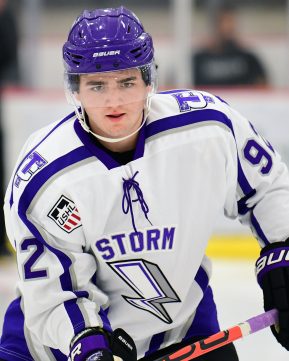Playing with Cedar Rapids last year, Mitchell Miller had enough flashes for me to slot his name away in the darker regions of my mind as a player to keep an eye on in 2019-20. Moved to Tri-City in the off-season, I first saw him again at the season opening USHL Classic in the outskirts of Pittsburgh. Immediately, he struck me as a player that was primed to take the leap.He was more dynamic, he made plays, pushed the pace, and generally showed that he could impose his will on the ice at any time.
As the season progressed, the North Dakota commit did just that with ever greater frequency. At this point, I believe that Miller is the top draft eligible defender among the non-USNTDP USHLers, and no one else is particularly close. True, some of that is a factor of the USHL being light on the blueline this year, but Miller is a legit good prospect. Between his high-end skating and puck skills and refined hockey sense and instincts, he looks like a potential second pairing defender with some power play time thrown in. He would not look out of place in the second round.
| Mitchell Miller | 2020 NHL Draft Eligible |
|---|---|
| Position: D, Shoots L | H/W: 5-11", 194 lbs |
| Stats to date (GP-G-A-PTS-PIMS) | Tri-City Storm, USHL (44-8-25-33-40) |
| USA U19, WJAC-19 (6-2-4-6-4) |

Skating: A true modern-era defender, with the compulsory skating chops included. The first thing one should note about Miller’s skating is his great edges, enabling him to stop and change direction on a dime, breaking ankles along the way. Some of his spins to evade forecheckers and get the puck out calmly have been breathtaking. His quickness is also a plus and he does well when he needs to race for a the puck with a good first few steps to get him off the mark in the lead. That acceleration leads to Miller leading his share of rushes from end to end. If there is a downside to his skating, I have reservations about his lateral mobility as I have not seen impressive line-walking from him, but then again, he doesn’t stay on the line that often anyway. Grade: 60
Shot: Miller has a solid one-timer from the point. When he has more time and elects for the wrist shot, he gets good whip on that as well. Although he led all USHL defensemen in shots taken, I would like to see him exhibit more patience from the point, and walk the line a little to create better angles. I think he could get there, but even if he doesn’t, there is enough for him to be a second unit power play guy. Grade: 55
Skills: A very composed puck mover, Miller combines his puck skills with his skating to present dynamic elements fairly regularly. He has very good vision and is a creative passer. Coming up the ice near the wall as he approaches a defender, he can pull off the self-pass off the boards, the puck going to the right as he goes around the backchecker on the left to meet up with the puck on the other side. His puck control is high end. He can dangle at top speed to evade the defense as he prepares to attach the home plate area. Grade: 60
Smarts: While Miller gets time in defensive situations with Tri-City, I would not expect that to remain the case as he moves on to North Dakota next season. His aforementioned vision is an asset. Furthermore, he positions himself well off the puck, and can use his stick to very good effect to help shut down opponents. Even if he doesn’t project as a shut-down type, Miller will be usable enough that he won’t need to be shielded. Grade: 50
Physicality: Miller is a bit hit or miss in terms of the physical game. Literally. He has a physical side, and I have seen him level a player with a big hip check. But this is not a major part of his game. More consistently, he will take a hit to make a play and he has never been shy to play in greasy areas. He seems well built despite not being big and that should be good enough for him to play his game. Grade: 50
Overall Future Projection (OFP): 54.75
A note on the 20-80 scale used above. We look at five attributes (skating, shooting, puck skills, hockey IQ and physicality) for skaters and six for goalies (athleticism/quickness, compete/temperament, vision/play reading, technique/style, rebound control and puck handling). Each individual attribute is graded along the 20-80 scales, which includes half-grades. The idea is that a projection of 50 in a given attribute meant that our observer believed that the player could get to roughly NHL average at that attribute at maturity.































